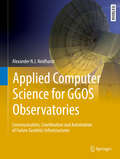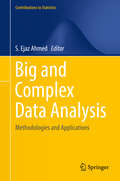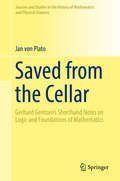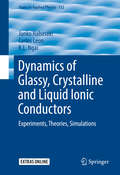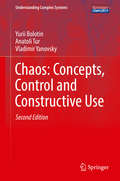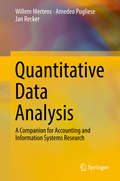- Table View
- List View
Applied Computer Science for GGOS Observatories: Communication, Coordination and Automation of Future Geodetic Infrastructures (Springer Textbooks in Earth Sciences, Geography and Environment)
by Alexander N.J. NeidhardtThis book combines elementary theory from computer science with real-world challenges in global geodetic observation, based on examples from the Geodetic Observatory Wettzell, Germany. It starts with a step-by-step introduction to developing stable and safe scientific software to run successful software projects. The use of software toolboxes is another essential aspect that leads to the application of generative programming. An example is a generative network middleware that simplifies communication. One of the book’s main focuses is on explaining a potential strategy involving autonomous production cells for space geodetic techniques. The complete software design of a satellite laser ranging system is taken as an example. Such automated systems are then combined for global interaction using secure communication tunnels for remote access. The network of radio telescopes is used as a reference. Combined observatories form coordinated multi-agent systems and offer solutions for operational aspects of the Global Geodetic Observing System (GGOS) with regard to “Industry 4.0”.
The Art of Modeling Mechanical Systems (CISM International Centre for Mechanical Sciences #570)
by Friedrich Pfeiffer Hartmut BremerThe papers in this volume present rules for mechanical models in a general systematic way, always in combination with small and large examples, many from industry, illustrating the most important features of modeling. The best way to reach a good solution is discussed. The papers address researchers and engineers from academia and from industry, doctoral students and postdocs, working in the fields of mechanical, civil and electrical engineering as well as in fields like applied physics or applied mathematics.
Capacitated Planned Maintenance: Models, Optimization Algorithms, Combinatorial and Polyhedral Properties (Lecture Notes in Economics and Mathematical Systems #686)
by Torben KuschelThis book examines the problem of maintenance planning and scheduling in industrial production systems. It presents two practically relevant, deterministic mathematical models: the capacitated planned maintenance problem (CPMP) and the weighted uncapacitated planned maintenance problem (WUPMP). It introduces specific optimization algorithms such as construction heuristics, Lagrangean and tabu search metaheuristics. A problem independent hybrid approach links and alternates between two Lagrangean relaxations. It also analyzes the solvability with respect to the computational complexity of several problem classes, polyhedral properties and lower bounds. Computational studies demonstrate the performance of the heuristics, lower bounds, subgradients obtained from heuristics and the quality of dual information. This unique book includes implementation details and an introduction to the necessary theory making it suitable for upper undergraduate students.
Granular, Soft and Fuzzy Approaches for Intelligent Systems: Dedicated to Professor Ronald R. Yager (Studies in Fuzziness and Soft Computing #344)
by Janusz Kacprzyk Dimitar Filev Gleb BeliakovThis book offers a comprehensive report on the state-of-the art in the broadly-intended field of “intelligent systems”. After introducing key theoretical issues, it describes a number of promising models for data and system analysis, decision making, and control. It discusses important theories, including possibility theory, the Dempster-Shafer theory, the theory of approximate reasoning, as well as computing with words, together with novel applications in various areas, such as information aggregation and fusion, linguistic data summarization, participatory learning, systems modeling, and many others. By presenting the methods in their application contexts, the book shows how granular computing, soft computing and fuzzy logic techniques can provide novel, efficient solutions to real-world problems. It is dedicated to Professor Ronald R. Yager for his great scientific and scholarly achievements, and for his long-lasting service to the fuzzy logic, and the artificial and computational intelligence communities. It has been motivated by the authors’ appreciation of his original thinking and groundbreaking ideas, with a special thought to his valuable research on the computerized implementation of various aspects of human cognition for decision-making and problem-solving.
Soil Dynamics and Foundation Modeling: Offshore and Earthquake Engineering (Risk Engineering)
by Junbo JiaThis book presents a comprehensive topical overview on soil dynamics and foundation modeling in offshore and earthquake engineering. The spectrum of topics include, but is not limited to, soil behavior, soil dynamics, earthquake site response analysis, soil liquefactions, as well as the modeling and assessment of shallow and deep foundations. The author provides the reader with both theory and practical applications, and thoroughly links the methodological approaches with engineering applications. The book also contains cutting-edge developments in offshore foundation engineering such as anchor piles, suction piles, pile torsion modeling, soil ageing effects and scour estimation. The target audience primarily comprises research experts and practitioners in the field of offshore engineering, but the book may also be beneficial for graduate students.
Classical and Quantum Cosmology (Graduate Texts in Physics)
by Gianluca CalcagniThis comprehensive textbook is devoted to classical and quantum cosmology, with particular emphasis on modern approaches to quantum gravity and string theory and on their observational imprint. It covers major challenges in theoretical physics such as the big bang and the cosmological constant problem. An extensive review of standard cosmology, the cosmic microwave background, inflation and dark energy sets the scene for the phenomenological application of all the main quantum-gravity and string-theory models of cosmology. Born of the author's teaching experience and commitment to bridging the gap between cosmologists and theoreticians working beyond the established laws of particle physics and general relativity, this is a unique text where quantum-gravity approaches and string theory are treated on an equal footing. As well as introducing cosmology to undergraduate and graduate students with its pedagogical presentation and the help of 45 solved exercises, this book, which includes an ambitious bibliography of about 3500 items, will serve as a valuable reference for lecturers and researchers.
Programming Phase-Field Modeling
by S. Bulent BinerThis textbook provides a fast-track pathway to numerical implementation of phase-field modeling—a relatively new paradigm that has become the method of choice for modeling and simulation of microstructure evolution in materials. It serves as a cookbook for the phase-field method by presenting a collection of codes that act as foundations and templates for developing other models with more complexity. Programming Phase-Field Modeling uses the Matlab/Octave programming package, simpler and more compact than other high-level programming languages, providing ease of use to the widest audience. Particular attention is devoted to the computational efficiency and clarity during development of the codes, which allows the reader to easily make the connection between the mathematical formulism and the numerical implementation of phase-field models. The background materials provided in each case study also provide a forum for undergraduate level modeling-simulations courses as part of their curriculum.
Enlargement of Filtration with Finance in View (SpringerBriefs in Quantitative Finance)
by Anna Aksamit Monique JeanblancThis volume presents classical results of the theory of enlargement of filtration. The focus is on the behavior of martingales with respect to the enlarged filtration and related objects. The study is conducted in various contexts including immersion, progressive enlargement with a random time and initial enlargement with a random variable. The aim of this book is to collect the main mathematical results (with proofs) previously spread among numerous papers, great part of which is only available in French. Many examples and applications to finance, in particular to credit risk modelling and the study of asymmetric information, are provided to illustrate the theory. A detailed summary of further connections and applications is given in bibliographic notes which enables to deepen study of the topic. This book fills a gap in the literature and serves as a guide for graduate students and researchers interested in the role of information in financial mathematics and in econometric science. A basic knowledge of the general theory of stochastic processes is assumed as a prerequisite.
Controller Tuning with Evolutionary Multiobjective Optimization: A Holistic Multiobjective Optimization Design Procedure (Intelligent Systems, Control and Automation: Science and Engineering #85)
by Gilberto Reynoso Meza Xavier Blasco Ferragud Javier Sanchis Saez Juan Manuel Herrero DuráThis book is devoted to Multiobjective Optimization Design (MOOD) procedures for controller tuning applications, by means of Evolutionary Multiobjective Optimization (EMO). It presents developments in tools, procedures and guidelines to facilitate this process, covering the three fundamental steps in the procedure: problem definition, optimization and decision-making. The book is divided into four parts. The first part, Fundamentals, focuses on the necessary theoretical background and provides specific tools for practitioners. The second part, Basics, examines a range of basic examples regarding the MOOD procedure for controller tuning, while the third part, Benchmarking, demonstrates how the MOOD procedure can be employed in several control engineering problems. The fourth part, Applications, is dedicated to implementing the MOOD procedure for controller tuning in real processes.
New Methods for Measuring and Analyzing Segregation (The Springer Series on Demographic Methods and Population Analysis #42)
by Mark FossettThis book is open access under a CC BY-NC 2.5 license.This book introduces new methods for measuring and analyzing residential segregation. It begins by placing all popular segregation indices in the “difference of group means” framework wherein index scores can be obtained as simple differences of group means on individual-level residential attainments scored from area racial composition. Drawing on the insight that in this framework index scores are additively determined by individual residential attainments, the book shows that the level of segregation in a given city can be equated to the effect of group membership (e.g., race) on individual residential attainments. This unifies separate research traditions in the field by joining the analysis of segregation at the aggregate level with the analysis of residential attainments for individuals. Next it shows how segregation analysis can be extended by using multivariate attainment models to assess the impact of group membership (i.e., the level of segregation for a city) while including controls for other relevant individual characteristics (e.g., income, education, language, nativity, etc.). It then illustrates how one can use these models to quantitatively assess the extent to which segregation traces to impacts of group membership on residential attainments versus other factors such as group differences in income. The book then shows how micro-level attainment models can be used to study macro-level variation in segregation; specifically, by estimating multi-level models of individual residential attainments to assess how the effect of group membership (i.e., segregation index scores) vary with city characteristics. Finally, the book introduces refined versions of popular indices that are free of the vexing problem of upward bias. This improves the quality of segregation measurement directly at the level of individual cases and expanding the number of cases that can be safely included in empirical studies.
Biomechanics: Trends in Modeling and Simulation (Studies in Mechanobiology, Tissue Engineering and Biomaterials #20)
by Gerhard A. Holzapfel Ray W. OgdenThe book presents a state-of-the-art overview of biomechanical and mechanobiological modeling and simulation of soft biological tissues. Seven well-known scientists working in that particular field discuss topics such as biomolecules, networks and cells as well as failure, multi-scale, agent-based, bio-chemo-mechanical and finite element models appropriate for computational analysis. Applications include arteries, the heart, vascular stents and valve implants as well as adipose, brain, collagenous and engineered tissues.The mechanics of the whole cell and sub-cellular components as well as the extracellular matrix structure and mechanotransduction are described. In particular, the formation and remodeling of stress fibers, cytoskeletal contractility, cell adhesion and the mechanical regulation of fibroblast migration in healing myocardial infarcts are discussed. The essential ingredients of continuum mechanics are provided. Constitutive models of fiber-reinforced materials with an emphasis on arterial walls and the myocardium are discussed and the important influence of residual stresses on material response emphasized. The mechanics and function of the heart, the brain and adipose tissues are discussed as well. Particular attention is focused on microstructural and multi-scale modeling, finite element implementation and simulation of cells and tissues.
Big and Complex Data Analysis: Methodologies and Applications (Contributions to Statistics)
by S. Ejaz AhmedThis volume conveys some of the surprises, puzzles and success stories in high-dimensional and complex data analysis and related fields. Its peer-reviewed contributions showcase recent advances in variable selection, estimation and prediction strategies for a host of useful models, as well as essential new developments in the field.The continued and rapid advancement of modern technology now allows scientists to collect data of increasingly unprecedented size and complexity. Examples include epigenomic data, genomic data, proteomic data, high-resolution image data, high-frequency financial data, functional and longitudinal data, and network data. Simultaneous variable selection and estimation is one of the key statistical problems involved in analyzing such big and complex data. The purpose of this book is to stimulate research and foster interaction between researchers in the area of high-dimensional data analysis. More concretely, its goals are to: 1) highlight and expand the breadth of existing methods in big data and high-dimensional data analysis and their potential for the advancement of both the mathematical and statistical sciences; 2) identify important directions for future research in the theory of regularization methods, in algorithmic development, and in methodologies for different application areas; and 3) facilitate collaboration between theoretical and subject-specific researchers.
Random Measures, Theory and Applications (Probability Theory and Stochastic Modelling #77)
by Olav KallenbergOffering the first comprehensive treatment of the theory of random measures, this book has a very broad scope, ranging from basic properties of Poisson and related processes to the modern theories of convergence, stationarity, Palm measures, conditioning, and compensation. The three large final chapters focus on applications within the areas of stochastic geometry, excursion theory, and branching processes. Although this theory plays a fundamental role in most areas of modern probability, much of it, including the most basic material, has previously been available only in scores of journal articles. The book is primarily directed towards researchers and advanced graduate students in stochastic processes and related areas.
Optimal Financial Decision Making under Uncertainty (International Series in Operations Research & Management Science #245)
by Giorgio Consigli Daniel Kuhn Paolo BrandimarteThe scope of this volume is primarily to analyze from different methodological perspectives similar valuation and optimization problems arising in financial applications, aimed at facilitating a theoretical and computational integration between methods largely regarded as alternatives. Increasingly in recent years, financial management problems such as strategic asset allocation, asset-liability management, as well as asset pricing problems, have been presented in the literature adopting formulation and solution approaches rooted in stochastic programming, robust optimization, stochastic dynamic programming (including approximate SDP) methods, as well as policy rule optimization, heuristic approaches and others. The aim of the volume is to facilitate the comprehension of the modeling and methodological potentials of those methods, thus their common assumptions and peculiarities, relying on similar financial problems. The volume will address different valuation problems common in finance related to: asset pricing, optimal portfolio management, risk measurement, risk control and asset-liability management.The volume features chapters of theoretical and practical relevance clarifying recent advances in the associated applied field from different standpoints, relying on similar valuation problems and, as mentioned, facilitating a mutual and beneficial methodological and theoretical knowledge transfer. The distinctive aspects of the volume can be summarized as follows:Strong benchmarking philosophy, with contributors explicitly asked to underline current limits and desirable developments in their areas.Theoretical contributions, aimed at advancing the state-of-the-art in the given domain with a clear potential for applicationsThe inclusion of an algorithmic-computational discussion of issues arising on similar valuation problems across different methods.Variety of applications: rarely is it possible within a single volume to consider and analyze different, and possibly competing, alternative optimization techniques applied to well-identified financial valuation problems.Clear definition of the current state-of-the-art in each methodological and applied area to facilitate future research directions.
An Introduction to the Language of Category Theory (Compact Textbooks in Mathematics)
by Steven RomanThis textbook provides an introduction to elementary category theory, with the aim of making what can be a confusing and sometimes overwhelming subject more accessible. In writing about this challenging subject, the author has brought to bear all of the experience he has gained in authoring over 30 books in university-level mathematics.The goal of this book is to present the five major ideas of category theory: categories, functors, natural transformations, universality, and adjoints in as friendly and relaxed a manner as possible while at the same time not sacrificing rigor. These topics are developed in a straightforward, step-by-step manner and are accompanied by numerous examples and exercises, most of which are drawn from abstract algebra. The first chapter of the book introduces the definitions of category and functor and discusses diagrams,duality, initial and terminal objects, special types of morphisms, and some special types of categories,particularly comma categories and hom-set categories. Chapter 2 is devoted to functors and naturaltransformations, concluding with Yoneda's lemma. Chapter 3 presents the concept of universality and Chapter 4 continues this discussion by exploring cones, limits, and the most common categorical constructions – products, equalizers, pullbacks and exponentials (along with their dual constructions). The chapter concludes with a theorem on the existence of limits. Finally, Chapter 5 covers adjoints and adjunctions.Graduate and advanced undergraduates students in mathematics, computer science, physics, or related fields who need to know or use category theory in their work will find An Introduction to Category Theory to be a concise and accessible resource. It will be particularly useful for those looking for a more elementary treatment of the topic before tackling more advanced texts.
Lectures in Feedback Design for Multivariable Systems (Advanced Textbooks in Control and Signal Processing)
by Alberto IsidoriThis book focuses on methods that relate, in one form or another, to the “small-gain theorem”. It is aimed at readers who are interested in learning methods for the design of feedback laws for linear and nonlinear multivariable systems in the presence of model uncertainties. With worked examples throughout, it includes both introductory material and more advanced topics.Divided into two parts, the first covers relevant aspects of linear-systems theory, the second, nonlinear theory. In order to deepen readers’ understanding, simpler single-input–single-output systems generally precede treatment of more complex multi-input–multi-output (MIMO) systems and linear systems precede nonlinear systems. This approach is used throughout, including in the final chapters, which explain the latest advanced ideas governing the stabilization, regulation, and tracking of nonlinear MIMO systems. Two major design problems are considered, both in the presence of model uncertainties: asymptotic stabilization with a “guaranteed region of attraction” of a given equilibrium point and asymptotic rejection of the effect of exogenous (disturbance) inputs on selected regulated outputs.Much of the introductory instructional material in this book has been developed for teaching students, while the final coverage of nonlinear MIMO systems offers readers a first coordinated treatment of completely novel results. The worked examples presented provide the instructor with ready-to-use material to help students to understand the mathematical theory.Readers should be familiar with the fundamentals of linear-systems and control theory. This book is a valuable resource for students following postgraduate programs in systems and control, as well as engineers working on the control of robotic, mechatronic and power systems.
Saved from the Cellar: Gerhard Gentzen’s Shorthand Notes on Logic and Foundations of Mathematics (Sources and Studies in the History of Mathematics and Physical Sciences)
by Jan Von PlatoGerhard Gentzen is best known for his development of the proof systems of natural deduction and sequent calculus, central in many areas of logic and computer science today. Another noteworthy achievement is his resolution of the embarrassing situation created by Gödel's incompleteness results, especially the second one about the unprovability of consistency of elementary arithmetic. After these successes, Gentzen dedicated the rest of his short life to the main problem of Hilbert's proof theory, the question of the consistency of analysis. He was arrested in the summer of 1945 with other professors of the German University of Prague and died soon afterward of starvation in a prison cell. Attempts at locating his lost manuscripts failed at the time, but several decades later, two slim folders of shorthand notes were found. In this volume, Jan von Plato gives an overview of Gentzen's life and scientific achievements, based on detailed archival and systematic studies, and essential for placing the translations of shorthand manuscripts that follow in the right setting. The materials in this book are singular in the way they show the birth and development of Gentzen's central ideas and results, sometimes in a well-developed form, and other times as flashes into the anatomy of the workings of a unique mind.
Optimal Control of a Double Integrator: A Primer on Maximum Principle (Studies in Systems, Decision and Control #68)
by Arturo LocatelliThis book provides an introductory yet rigorous treatment of Pontryagin’s Maximum Principle and its application to optimal control problems when simple and complex constraints act on state and control variables, the two classes of variable in such problems. The achievements resulting from first-order variational methods are illustrated with reference to a large number of problems that, almost universally, relate to a particular second-order, linear and time-invariant dynamical system, referred to as the double integrator. The book is ideal for students who have some knowledge of the basics of system and control theory and possess the calculus background typically taught in undergraduate curricula in engineering.Optimal control theory, of which the Maximum Principle must be considered a cornerstone, has been very popular ever since the late 1950s. However, the possibly excessive initial enthusiasm engendered by its perceived capability to solve any kind of problem gave way to its equally unjustified rejection when it came to be considered as a purely abstract concept with no real utility. In recent years it has been recognized that the truth lies somewhere between these two extremes, and optimal control has found its (appropriate yet limited) place within any curriculum in which system and control theory plays a significant role.
Dynamics of Glassy, Crystalline and Liquid Ionic Conductors: Experiments, Theories, Simulations (Topics in Applied Physics #132)
by Junko Habasaki Carlos Leon K. L. NgaiThis book discusses the physics of the dynamics of ions in various ionically conducting materials, and applications including electrical energy generation and storage. The experimental techniques for measurements and characterization, molecular dynamics simulations, the theories of ion dynamics, and applications are all addressed by the authors, who are experts in their fields. The experimental techniques of measurement and characterization of dynamics of ions in glassy, crystalline, and liquid ionic conductors are introduced with the dual purpose of introducing the reader to the experimental activities of the field, and preparing the reader to understand the physical quantities derived from experiments. These experimental techniques include calorimetry, conductivity relaxation, nuclear magnetic resonance, light scattering, neutron scattering, and others. Methods of molecular dynamics simulations are introduced to teach the reader to utilize the technique for practical applications to specific problems. The results elucidate the dynamics of ions on some issues that are not accessible by experiments. The properties of ion dynamics in glassy, crystalline and liquid ionic conductors brought forth by experiments and simulations are shown to be universal, i.e. independent of physical and chemical structure of the ionic conductor as long as ion-ion interaction is the dominant factor. Moreover these universal properties of ion dynamics are shown to be isomorphic to other complex interacting systems including the large class of glass-forming materials with or without ionic conductivity.By covering the basic concepts, theories/models, experimental techniques and data, molecular dynamics simulations, and relating them together, Dynamics of Glassy, Crystalline and Liquid Ionic Conductors will be of great interest to many in basic and applied research areas from the broad and diverse communities of condensed matter physicists, chemists, materials scientists and engineers. The book also provides the fundamentals for an introduction to the field and it is written in such a way that can be used for teaching courses either at the undergraduate or graduate level in academic institutions.
Chaos: Concepts, Control And Constructive Use (Understanding Complex Systems)
by Yurii Bolotin Anatoli Tur Vladimir YanovskyThis book offers a short and concise introduction to the many facets of chaos theory.While the study of chaotic behavior in nonlinear, dynamical systems is a well-established research field with ramifications in all areas of science, there is a lot to be learnt about how chaos can be controlled and, under appropriate conditions, can actually be constructive in the sense of becoming a control parameter for the system under investigation, stochastic resonance being a prime example.The present work stresses the latter aspects and, after recalling the paradigm changes introduced by the concept of chaos, leads the reader skillfully through the basics of chaos control by detailing the relevant algorithms for both Hamiltonian and dissipative systems, among others.The main part of the book is then devoted to the issue of synchronization in chaotic systems, an introduction to stochastic resonance, and a survey of ratchet models. In this second, revised and enlarged edition, two more chapters explore the many interfaces of quantum physics and dynamical systems, examining in turn statistical properties of energy spectra, quantum ratchets, and dynamical tunneling, among others.This text is particularly suitable for non-specialist scientists, engineers, and applied mathematical scientists from related areas, wishing to enter the field quickly and efficiently.From the reviews of the first edition: This book is an excellent introduction to the key concepts and control of chaos in (random) dynamical systems [...] The authors find an outstanding balance between main physical ideas and mathematical terminology to reach their audience in an impressive and lucid manner. This book is ideal for anybody who would like to grasp quickly the main issues related to chaos in discrete and continuous time. Henri Schurz, Zentralblatt MATH, Vol. 1178, 2010.
Uses of Technology in Upper Secondary Mathematics Education (ICME-13 Topical Surveys)
by Stephen Hegedus Colette Laborde Corey Brady Sara Dalton Hans-Stefan Siller Michal Tabach Jana Trgalova Luis Moreno-ArmellaThis survey addresses the use of technology in upper secondary mathematics education from four points of view: theoretical analysis of epistemological and cognitive aspects of activity in new technology mediated learning environments, the changes brought by technology in the interactions between environment, students and teachers, the interrelations between mathematical activities and technology, skills and competencies that must be developed in teacher education. Research shows that the use of some technologies may deeply change the solving processes and contribute to impact the learning processes. The questions are which technologies to choose for which purposes, and how to integrate them, so as to maximize all students’ agency. In particular the role of the teacher in classrooms and the content of teacher education programs are critical for taking full advantage of technology in teaching practice.
Reduced Modelling of Planar Fuel Cells: Spatial Smoothing and Asymptotic Reduction
by Zhongjie He Hua Li Karl Erik BirgerssonThis book focuses on novel reduced cell and stack models for proton exchange membrane fuel cells (PEMFCs) and planar solid oxide fuel cells (P-SOFCs) that serve to reduce the computational cost by two orders of magnitude or more with desired numerical accuracy, while capturing both the average properties and the variability of the dependent variables in the 3D counterparts. The information provided can also be applied to other kinds of plate-type fuel cells whose flow fields consist of parallel plain channels separated by solid ribs. These fast and efficient models allow statistical sensitivity analysis for a sample size in the order of 1000 without prohibitive computational cost to be performed to investigate not only the individual, but also the simultaneous effects of a group of varying geometrical, material, and operational parameters. This provides important information for cell/stack design, and to illustrate this, Monte Carlo simulation of the reduced P-SOFC model is conducted at both the single-cell and stack levels.
Periodic Flows to Chaos in Time-delay Systems (Nonlinear Systems and Complexity #16)
by Albert C. LuoThis book for the first time examines periodic motions to chaos in time-delay systems, which exist extensively in engineering. For a long time, the stability of time-delay systems at equilibrium has been of great interest from the Lyapunov theory-based methods, where one cannot achieve the ideal results. Thus, time-delay discretization in time-delay systems was used for the stability of these systems. In this volume, Dr. Luo presents an accurate method based on the finite Fourier series to determine periodic motions in nonlinear time-delay systems. The stability and bifurcation of periodic motions are determined by the time-delayed system of coefficients in the Fourier series and the method for nonlinear time-delay systems is equivalent to the Laplace transformation method for linear time-delay systems.
Quantitative Data Analysis: A Companion for Accounting and Information Systems Research
by Willem Mertens Amedeo Pugliese Jan ReckerThis book offers postgraduate and early career researchers in accounting and information systems a guide to choosing, executing and reporting appropriate data analysis methods to answer their research questions. It provides readers with a basic understanding of the steps that each method involves, and of the facets of the analysis that require special attention. Rather than presenting an exhaustive overview of the methods or explaining them in detail, the book serves as a starting point for developing data analysis skills: it provides hands-on guidelines for conducting the most common analyses and reporting results, and includes pointers to more extensive resources. Comprehensive yet succinct, the book is brief and written in a language that everyone can understand - from students to those employed by organizations wanting to study the context in which they work. It also serves as a refresher for researchers who have learned data analysis techniques previously but who need a reminder for the specific study they are involved in.
Measuring Progress Towards Sustainability: A Treatise for Engineers
by Subhas K. Sikdar Debalina Sengupta Rajib MukherjeeThis book is a state of the art treatise on what has been done so far on measuring sustainability for decision making. Contributions will appeal to engineers and scientists engaged in technology development, assessment, and verification. Researchers working on engineering sustainability are likely to get ideas for further research in quantifying sustainability for industrial systems. Concepts described can be applied across all scales, from process technology to global sustainability; and challenges and limitations are also addressed. Readers will discover important insights about simulation-based approaches to process design and quantitative measurement techniques of sustainability for business and technology systems. Most of the examples and case studies are from chemical enterprises but the methodologies presented could be applicable to any system for which quantitative data for indicators are available, and the choice of the set of indicators of sustainability are comprehensive.
